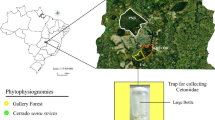Summary
The taxonomic composition and size of arthropods captured by Pinguicula nevadense, an endemic carnivorous plant of the high-mountain zone of the Sierra Nevada (southern Spain), are analysed. The actual prey of P. nevadense and the available arthropods trapped by “mimic-traps” are compared, in order to identify the capture constraints of the plant. The results show that P. nevadense captures various arthropod taxa. Winged insects, especially Nematocera, make up the main component of the diet. The range of prey sizes in all P. nevadense populations studied is similar. The taxonomic composition of arthropods trapped by the mimic-traps is similar to that of the actual prey of P. nevadense. However, the plant captures prey only below a specific size threshold. These size constraints appear to be the principal factor determining the actual prey of this carnivorous plant.
Similar content being viewed by others
References
Achtenberg CV (1973) A study about the Arthropoda caught by Drosera species. Entomol Ber 33:137–140
Aldenius J, Carlsson B, Karlsson S (1983) Effects of insect trapping on growth and nutrient content of Pinguicula vulgaris L. in relation to the nutrient content of the substrate. New Phytol 93:53–59
Darwin C (1875) Insectivorous plants. Appleton, London
Dixon KW, Pate JS, Bailey WJ (1980) Nitrogen nutrition of the tuberous sundew, Drosera erythrorhiza, with special reference to the catch of arthropods fauna by its glandular leaves. Aust J Bot 28:283–297
Fernandez Casas J (1974) Vegetación y flora de Sierra Nevada: los borreguiles. Bol Est Cent Ecol 5:29–35
Green S, Green TL, Heslop-Harrison Y (1979) Seasonal heterophylly and leaf gland features in Triphophyllum (Dioncophyllaceae), a new carnivorous plant genus Bot J Linn Soc 78:99–116
Heslop-Harrison Y, Keslop-Harrison J (1980) Chloride ion moment and enzyme secretion from the digestive glands of Pinguicula. Ann Bot 45:729–731
Heslop-Harrison Y, Knox RB (1971) A cytochemical study of the leaf-gland enzymes of insectivorous plants of the genus Pinguicula. Planta 96:183–211
Joel DM, Juniper BE, Dafni A (1985) Ultraviolet patterns in the traps of carnivorous plants. New Phytol 101:585–593
Juniper BE, Robins RB, Joel DM (1989) The Carnivorous Plants. Academic Press, London
Karlsson PS, Carlsson B (1984) Why does Pinguicula vulgaris L. trap insects? New Phytol 97:25–30
Karlsson PS, Nordell KO, Eirefelt S, Svensson A (1987) Trapping efficiency of three carnivorous Pinguicula species. Oecologia 73:518–521
Molero J, Perez F (1987) Contribución al catálago florístico de Sierra Nevada. Univ. Granada Press, Granada
Nentwig W (1982) Why do only certain insects escape from a spider's web? Oecologia 53:412–417
Pate JS, Dixon KW (1978) Mineral nutrition of Drosera erythrorhiza with special reference to its tuberous habit. Aust J Bot 26:455–464
Thompson JN (1981) Reversed animal-plant interaction: the evolution of insectivorous and ant-fed plants. Biol J Linn Soc 16:147–155
Thum M (1986) Segregation of habitat and prey in two sympatric carnivorous species, Drosera rotundifolia and Drosera intermedia. Oecologia 70:601–605
Watson AP, Mathiessen JN, Springett BP (1982) Arthropod associates and macronutrient status of the red ink sundew (Drosera erythrorhiza). Aust J Ecol 7:13–22
Zamora R (1990) Observational and experimental study of a Carnivorous plant-ant kleptobiotic interaction. Oikos (in press)
Author information
Authors and Affiliations
Rights and permissions
About this article
Cite this article
Zamora, R. The feeding ecology of a carnivorous plant (Pinguicula nevadense): prey analysis and capture constraints. Oecologia 84, 376–379 (1990). https://doi.org/10.1007/BF00329762
Received:
Accepted:
Issue Date:
DOI: https://doi.org/10.1007/BF00329762




